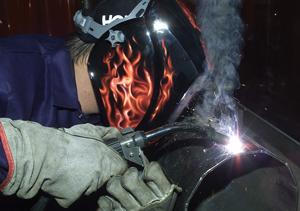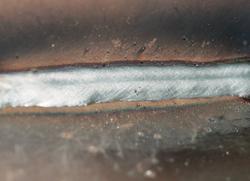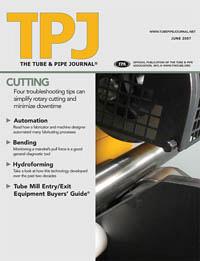- FMA
- The Fabricator
- FABTECH
- Canadian Metalworking
Categories
- Additive Manufacturing
- Aluminum Welding
- Arc Welding
- Assembly and Joining
- Automation and Robotics
- Bending and Forming
- Consumables
- Cutting and Weld Prep
- Electric Vehicles
- En Español
- Finishing
- Hydroforming
- Laser Cutting
- Laser Welding
- Machining
- Manufacturing Software
- Materials Handling
- Metals/Materials
- Oxyfuel Cutting
- Plasma Cutting
- Power Tools
- Punching and Other Holemaking
- Roll Forming
- Safety
- Sawing
- Shearing
- Shop Management
- Testing and Measuring
- Tube and Pipe Fabrication
- Tube and Pipe Production
- Waterjet Cutting
Industry Directory
Webcasts
Podcasts
FAB 40
Advertise
Subscribe
Account Login
Search
Beyond Commodity
Understanding and justifying a process change to metal-cored wires
- By Roger Pihl
- June 12, 2007
- Article
- Consumables
Because they comprise only about 4 percent of the overall cost of a welding operation, filler metals often are perceived as a simple commodity. They have a per-unit cost and require ongoing stocking, which separates them from equipment acquisitions in terms of expenditures and financial justifications. Or does it?
In today's high-level manufacturing environment, companies continually seek ways to improve productivity and lower costs to maintain their competitive edge. Often they look to new equipment technologies to achieve that edge, and rightly so. With all of the advances in power source technologies, often a fast return on investment in terms of productivity increases is achievable.
However, there also have been significant advancements in filler metal technology, many of which can complement the advancements of newer equipment or even enhance older equipment.
In recent years metal-cored wire has become an increasingly popular alternative to solid and flux-cored wire for many companies. Metal-cored wire reduces spatter, increases deposition rates, improves travel speed, and can weld effectively through mill scale or rust (see Figure 1). Yet with these benefits comes a slightly higher per-unit cost. So how can your company justify a process change to metal-cored wires?
Determining Your Baseline: Is There Potential for Improvement?
No company can justify additional expenditures or process changes without cause. As with equipment acquisitions, changing to metal-cored wire must offer a solution to specific problems, such as low productivity, high labor costs, a high volume of rework, or other factors affecting product quality and the overall profitability of the welding operation.
As such, a potential switch to metal-cored wire requires assessing the entire welding operation, looking not only to the weld cell but also to the pre- and postweld areas to determine the impact of the current filler metal on productivity and costs.
To establish a baseline against which to measure the potential for improvement, look first at the preweld area to determine activities that cause bottlenecks or slowdowns in the beginning of the welding operation. Because the preweld area often is used for activities such as grinding mill scale, applying antispatter, or degreasing materials, companies can incur additional labor costs here. These activities also can affect operations further downstream and add expenses to the overall operation.
If you have a preweld area, first quantify the amount of labor and time spent on grinding and other weld preparation, and consider the cost of maintaining or replacing the equipment necessary for these activities. A welding distributor or equipment supplier can usually help in this assessment. If you use antispatter, consider the cost for purchasing it and the labor necessary for applying it and cleaning the preweld area.
Also look at the weld cell and postweld area of the operation. Measure the actual amount of arc-on time, how many parts can be welded in a shift, the quality of the parts being produced, and the welding parameters at which the operation is running.
In semiautomatic welding applications, review the impact of the welding cell on welding operators' health. With certain filler metals, such as solid wire, operators often oscillate their gas metal arc welding (GMAW) gun to create fillet welds and may suffer wrist problems as a result. In this case, you should quantify the amount of worker compensation claims caused by such injuries.
Consider the amount of rework necessary for each part using the current filler metal. If undercut, lack of fusion, or spatter is a problem, quantify the amount of labor and time necessary for reworking parts and grinding spatter and the number of parts that must be completely rejected.
Metal-cored Wire: What Do You Need to Know?
If after assessing the pre-, weld, and postweld areas you find high labor costs, low productivity, bottlenecks, or excessive rework, a process change could be beneficial.
Research shows that metal-cored wire can minimize labor costs for pre-and postweld activities and improve productivity in the weld cell. There are several reasons for these improvements.
First, metal-cored wire can weld through mill scale and rust while still achieving a smooth weld bead. That is because metal-cored wires can be manufactured with deoxidizers and scavengers that control cleaning action and weld bead profiles. Second, at equivalent amperage settings, metal-cored wire effectively carries higher current densities than solid wire: In a solid wire, the entire cross-sectional area conducts the current; in a metal-cored wire, the outer sheath does the job. This results in higher relative burnoff rates and translates into the potential for increased deposition rates, fast travel speeds, and greater overall throughput.
When using metal-cored wire, it is also possible to increase wire diameter by one size over a solid wire, which allows you to weld a variety of material thicknesses and joints and standardize on a single wire diameter throughout the welding operation. In addition, metal-cored wire reduces molten metal droplet transfer to minimize spatter and create a wide weld metal projection area for better bridging of part gaps.
Payback: How Can You Justify a Change?
Looking at the features and benefits of metal-cored wire is one thing; justifying a process change is quite another. To substantiate the higher per-unit cost, you need to consider how the benefits can translate into real paybacks.
A good first step is to establish key measurements against which to analyze potential improvements in the welding operation. For example, if you think you can eliminate pre- or postweld activities (including antispatter application or grinding) by using metal-cored wire, consider how much this might help to reduce labor costs or whether labor could be reallocated to the weld cell to produce more parts.
Other key measurements to consider are reduced rework and lower warranty costs. Research and application studies indicate that metal-cored wire can bridge gaps more readily than solid wire; a process change could yield significant results in terms of reduced labor costs for part rework or material costs for rejected parts.
Additionally, you should consider the possibility of higher productivity. If a company can produce better parts faster with metal-cored wire, there may be a potential for lowering warranty costs (not to mention increasing customer satisfaction) and increasing the overall throughput of the operation.
Once each of these factors has been considered, it is important for you to calculate the payback of each potential improvement. Doing so may require running a trial of the wire in a portion of the welding operation—local welding distributors or a filler metal manufacturer can assist with this process.
No single piece of equipment or spool of wire will yield immediate results in a welding operation. For this reason, considering a process change to metal-cored wire is as much a matter of being productivity-minded as it is of having a long-term vision for improvement. Remember, higher upfront costs often can give way to higher quality and productivity.
About the Author
Roger Pihl
101 Trade Square E.
Troy, OH 45373
800-424-1543
About the Publication
Related Companies
subscribe now

The Tube and Pipe Journal became the first magazine dedicated to serving the metal tube and pipe industry in 1990. Today, it remains the only North American publication devoted to this industry, and it has become the most trusted source of information for tube and pipe professionals.
start your free subscription- Stay connected from anywhere

Easily access valuable industry resources now with full access to the digital edition of The Fabricator.

Easily access valuable industry resources now with full access to the digital edition of The Welder.

Easily access valuable industry resources now with full access to the digital edition of The Tube and Pipe Journal.
- Podcasting
- Podcast:
- The Fabricator Podcast
- Published:
- 04/16/2024
- Running Time:
- 63:29
In this episode of The Fabricator Podcast, Caleb Chamberlain, co-founder and CEO of OSH Cut, discusses his company’s...
- Trending Articles
Team Industries names director of advanced technology and manufacturing

Orbital tube welding webinar to be held April 23

3D laser tube cutting system available in 3, 4, or 5 kW

Corrosion-inhibiting coating can be peeled off after use

Brushless copper tubing cutter adjusts to ODs up to 2-1/8 in.

- Industry Events
16th Annual Safety Conference
- April 30 - May 1, 2024
- Elgin,
Pipe and Tube Conference
- May 21 - 22, 2024
- Omaha, NE
World-Class Roll Forming Workshop
- June 5 - 6, 2024
- Louisville, KY
Advanced Laser Application Workshop
- June 25 - 27, 2024
- Novi, MI




























